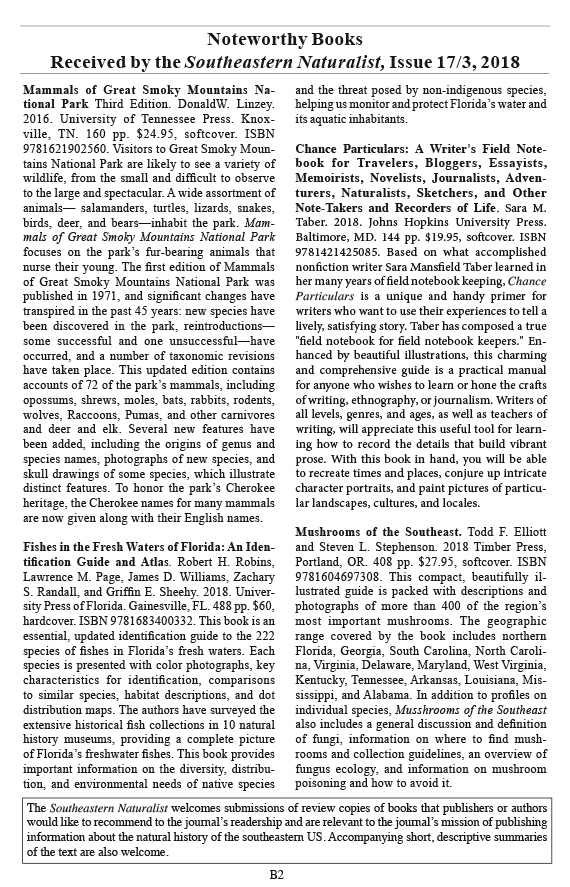Southeastern Naturalist
Noteworthy Books
2018 Vol. 167 No. 2
B2
Mammals of Great Smoky Mountains National
Park Third Edition. DonaldW. Linzey.
2016. University of Tennessee Press. Knoxville,
TN. 160 pp. $24.95, softcover. ISBN
9781621902560. Visitors to Great Smoky Mountains
National Park are likely to see a variety of
wildlife, from the small and difficult to observe
to the large and spectacular. A wide assortment of
animals— salamanders, turtles, lizards, snakes,
birds, deer, and bears—inhabit the park. Mammals
of Great Smoky Mountains National Park
focuses on the park’s fur-bearing animals that
nurse their young. The first edition of Mammals
of Great Smoky Mountains National Park was
published in 1971, and significant changes have
transpired in the past 45 years: new species have
been discovered in the park, reintroductions—
some successful and one unsuccessful—have
occurred, and a number of taxonomic revisions
have taken place. This updated edition contains
accounts of 72 of the park’s mammals, including
opossums, shrews, moles, bats, rabbits, rodents,
wolves, Raccoons, Pumas, and other carnivores
and deer and elk. Several new features have
been added, including the origins of genus and
species names, photographs of new species, and
skull drawings of some species, which illustrate
distinct features. To honor the park’s Cherokee
heritage, the Cherokee names for many mammals
are now given along with their English names.
Fishes in the Fresh Waters of Florida: An Identification
Guide and Atlas. Robert H. Robins,
Lawrence M. Page, James D. Williams, Zachary
S. Randall, and Griffin E. Sheehy. 2018. University
Press of Florida. Gainesville, FL. 488 pp. $60,
hardcover. ISBN 9781683400332. This book is an
essential, updated identification guide to the 222
species of fishes in Florida’s fresh waters. Each
species is presented with color photographs, key
characteristics for identification, comparisons
to similar species, habitat descriptions, and dot
distribution maps. The authors have surveyed the
extensive historical fish collections in 10 natural
history museums, providing a complete picture
of Florida’s freshwater fishes. This book provides
important information on the diversity, distribution,
and environmental needs of native species
and the threat posed by non-indigenous species,
helping us monitor and protect Florida’s water and
its aquatic inhabitants.
Chance Particulars: A Writer's Field Notebook
for Travelers, Bloggers, Essayists,
Memoirists, Novelists, Journalists, Adventurers,
Naturalists, Sketchers, and Other
Note-Takers and Recorders of Life. Sara M.
Taber. 2018. Johns Hopkins University Press.
Baltimore, MD. 144 pp. $19.95, softcover. ISBN
9781421425085. Based on what accomplished
nonfiction writer Sara Mansfield Taber learned in
her many years of field notebook keeping, Chance
Particulars is a unique and handy primer for
writers who want to use their experiences to tell a
lively, satisfying story. Taber has composed a true
"field notebook for field notebook keepers." Enhanced
by beautiful illustrations, this charming
and comprehensive guide is a practical manual
for anyone who wishes to learn or hone the crafts
of writing, ethnography, or journalism. Writers of
all levels, genres, and ages, as well as teachers of
writing, will appreciate this useful tool for learning
how to record the details that build vibrant
prose. With this book in hand, you will be able
to recreate times and places, conjure up intricate
character portraits, and paint pictures of particular
landscapes, cultures, and locales.
Mushrooms of the Southeast. Todd F. Elliott
and Steven L. Stephenson. 2018 Timber Press,
Portland, OR. 408 pp. $27.95, softcover. ISBN
9781604697308. This compact, beautifully illustrated
guide is packed with descriptions and
photographs of more than 400 of the region’s
most important mushrooms. The geographic
range covered by the book includes northern
Florida, Georgia, South Carolina, North Carolina,
Virginia, Delaware, Maryland, West Virginia,
Kentucky, Tennessee, Arkansas, Louisiana, Mississippi,
and Alabama. In addition to profiles on
individual species, Musshrooms of the Southeast
also includes a general discussion and definition
of fungi, information on where to find mushrooms
and collection guidelines, an overview of
fungus ecology, and information on mushroom
poisoning and how to avoid it.
Noteworthy Books
Received by the Southeastern Naturalist, Issue 17/3, 2018
The Southeastern Naturalist welcomes submissions of review copies of books that publishers or authors
would like to recommend to the journal’s readership and are relevant to the journal’s mission of publishing
information about the natural history of the southeastern US. Accompanying short, descriptive summaries
of the text are also welcome.














 The Southeastern Naturalist is a peer-reviewed journal that covers all aspects of natural history within the southeastern United States. We welcome research articles, summary review papers, and observational notes.
The Southeastern Naturalist is a peer-reviewed journal that covers all aspects of natural history within the southeastern United States. We welcome research articles, summary review papers, and observational notes.